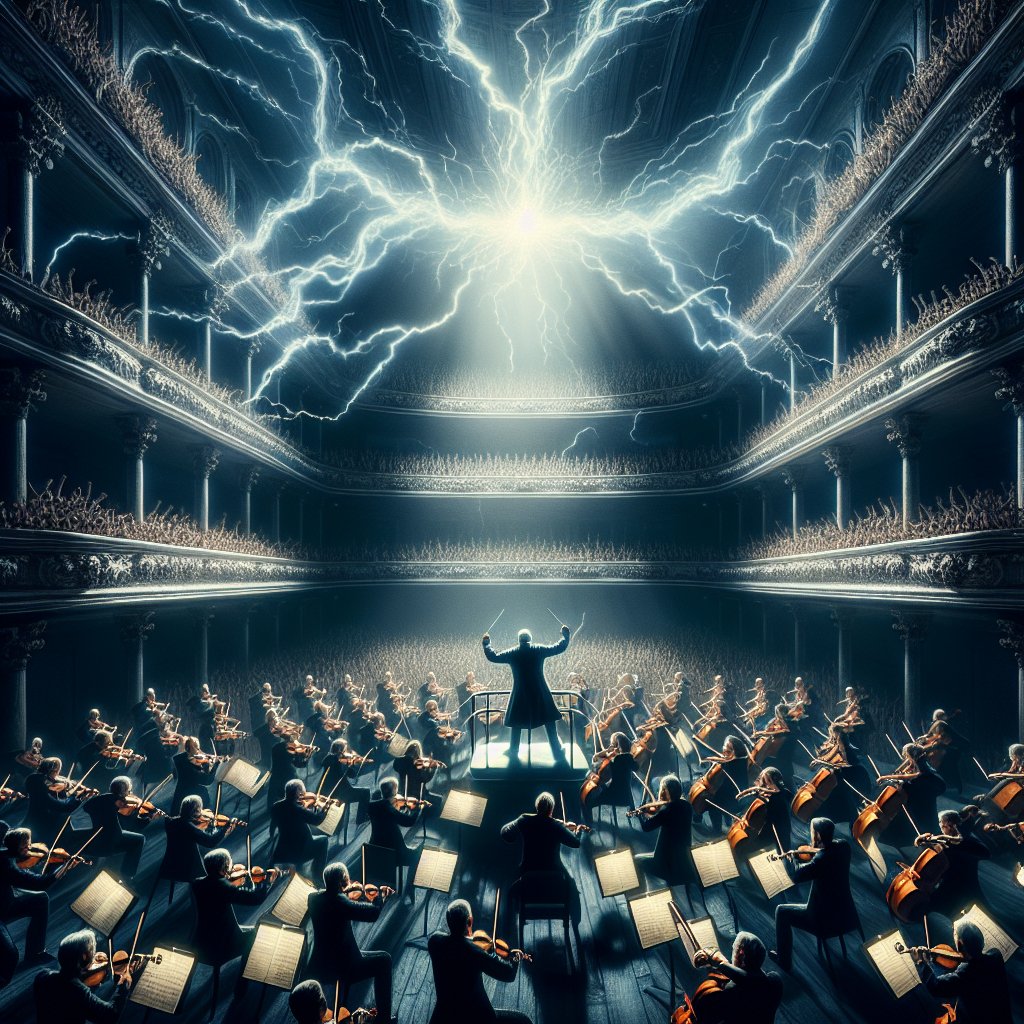
The Power and Drama in Beethoven’s Egmont Overture
Ludwig van Beethoven remains one of the most influential figures in the history of Western music. Known not just for his symphonies and piano sonatas, Beethoven’s impact encompassed a wide range of musical forms including variations, dances, and particularly, overtures. Within his illustrious repertoire, the Egmont Overture stands out as an epitome of his ability to convey deep emotion and dramatic storytelling through music. Composed between 1809 and 1810, the Egmont Overture was commissioned to accompany Johann Wolfgang von Goethe’s play of the same name. This piece not only showcases Beethoven’s mastery in orchestral writing but also serves as a testament to his philosophical ideals and enduring spirit amid personal tribulations.
Egmont, a tragic figure who fought for freedom against Spanish oppression in the Netherlands, resonated deeply with Beethoven. His admiration for Goethe and his own political inclinations infused the music with a sense of heroism and defiance. This overture encapsulates the turmoil, the struggle, and the ultimate sacrifice of its protagonist, making it a powerful and moving piece that has endured through the ages. By examining Beethoven’s use of dynamic contrasts, thematic development, and orchestration in the Egmont Overture, we can gain a deeper understanding of his compositional genius and artistic vision.
In this comprehensive article, we will explore the different facets of Beethoven’s Egmont Overture, from its historical context and inspiration to its intricate musical structure. Through analyzing these elements, we aim to appreciate the enduring power and drama that this overture holds and why it continues to captivate audiences nearly two centuries later. Whether you’re a seasoned classical music aficionado or a curious newcomer, this journey through Beethoven’s Egmont Overture will offer rich insights into one of his most remarkable orchestral works.
Historical Context and Inspiration
The historical context surrounding the creation of the Egmont Overture is crucial to understanding its depth and significance. When Beethoven was asked to compose this piece in 1809, Europe was in the throes of the Napoleonic Wars. The conflict and political landscape left a profound impact on Beethoven, who was known for his liberal and anti-tyrannical views. This turbulent time mirrored the setting of Goethe’s “Egmont,” which is set during the Eighty Years’ War—a period marked by the Dutch struggle for independence from Spanish rule.
Johann Wolfgang von Goethe’s play “Egmont” dramatizes the life of Count Egmont, a Dutch nobleman who fought against Spanish oppression and was ultimately executed. Egmont’s martyrdom became a symbol of the fight for freedom and justice, themes that resonated deeply with Beethoven. The commission to write an overture for this play gave Beethoven an opportunity to express his political convictions through music.
Beethoven’s admiration for Goethe’s literary prowess only fueled his passion for this project. Goethe, an intellectual giant of his time, was a source of inspiration for many artists and thinkers. Beethoven saw in Goethe’s Egmont a story that not only aligned with his own ideals but also provided a powerful narrative that could be enriched and elevated through music. The Egmont Overture is thus not just a musical introduction to a play; it stands alone as a dramatic and emotional work that conveys the essence of its protagonist’s struggle and spirit.
The period in which Beethoven composed this overture was also marked by his personal struggles with deafness and isolation. Despite these challenges, he poured his heart and soul into the composition, creating a piece that speaks to universal themes of resistance, sacrifice, and heroism. The Egmont Overture, therefore, serves as a reflection of Beethoven’s inner turmoil and his unwavering commitment to artistic and moral ideals.
Musical Structure and Thematic Elements
The Egmont Overture is a masterful example of Beethoven’s ability to use musical elements to convey narrative and emotion. The piece follows a traditional overture form but is imbued with Beethoven’s unique touch and innovation. The overture opens with a somber, slow introduction that sets the stage for the unfolding drama. This introductory section, marked by dark and brooding chords, represents the oppression and despair faced by the Dutch under Spanish domination.
As the music progresses, Beethoven introduces a bold and powerful main theme that symbolizes Count Egmont’s bravery and defiance. This theme is characterized by its strong rhythmic drive and dramatic intensity, embodying the spirit of resistance. Beethoven’s use of dynamic contrasts is particularly striking in this section, with sudden shifts from soft, introspective passages to loud, forceful statements. These changes in dynamics enhance the emotional impact of the music and mirror the turmoil and conflict central to the story.
One of the most remarkable aspects of the Egmont Overture is Beethoven’s use of orchestration to paint vivid musical pictures. He employs a full symphonic orchestra, with each section contributing to the overall texture and drama of the piece. The strings often play an essential role in driving the momentum and intensity, while the brass and woodwinds add color and emphasis to critical moments. Notably, the timpani provide a sense of foreboding and urgency, punctuating the musical narrative with their powerful, resonant beats.
The development section of the overture showcases Beethoven’s skill in thematic transformation and development. He takes the initial motifs and weaves them into complex, intertwined passages that build tension and anticipation. This section is marked by a sense of struggle and striving, reflecting Egmont’s fight against tyranny. Finally, the piece culminates in a triumphant coda, where the main theme re-emerges in a blazing, victorious form. This resolution serves not only as a musical climax but also as a symbolic representation of the triumph of freedom and justice.

Reception and Legacy
Since its premiere, the Egmont Overture has been celebrated for its dramatic power and emotional depth. Audiences and critics alike have praised Beethoven’s ability to translate the essence of Goethe’s play into music, creating a work that stands as a powerful statement on its own. The overture’s success has cemented its place in the concert repertoire, and it continues to be performed regularly by orchestras around the world.
The Egmont Overture has also had a significant impact on the cultural and artistic landscape. Beyond the concert hall, this piece has been used in various contexts to evoke themes of heroism, struggle, and triumph. Notably, it was adopted as an anthem of resistance during times of political upheaval, such as the Hungarian Revolution of 1956. The overture’s association with the fight for freedom and justice has made it a symbol of resilience and hope for many.
In the realm of classical music, the Egmont Overture stands as a testament to Beethoven’s genius and his ability to infuse music with profound meaning. It has inspired countless musicians, composers, and conductors, who continue to study and interpret this work with great admiration. The overture’s enduring popularity is a testament to its timeless appeal and the universal themes it embodies.
Moreover, the Egmont Overture has influenced other forms of art and media. Its stirring melodies and dramatic structure have made it a favorite choice for film scores and theatrical productions, where its powerful music can enhance and elevate the narrative. In this way, Beethoven’s Egmont Overture continues to captivate and inspire new generations, maintaining its relevance and impact in the modern world.
Analysis and Interpretation
To fully appreciate the brilliance of the Egmont Overture, it is essential to delve into its musical analysis and interpretation. One of the key elements that stands out is Beethoven’s use of motifs and their development throughout the piece. The main theme, introduced early on, undergoes various transformations that reflect the changing emotional landscape of the narrative. This thematic cohesion gives the overture a sense of unity and progression, mirroring the journey of its protagonist, Count Egmont.
Beethoven’s use of harmony and dissonance also plays a crucial role in creating the overture’s dramatic tension. He often employs unexpected harmonic shifts and dissonant chords to heighten the sense of conflict and unease. These musical elements not only add to the emotional intensity but also serve as a symbolic representation of the struggle against oppression.
Another striking feature of the Egmont Overture is its rhythmic drive and energy. Beethoven’s use of rhythmic patterns and accents adds a dynamic quality to the music, propelling it forward with urgency and determination. This rhythmic vitality is particularly evident in the main theme and its subsequent developments, which capture the essence of Egmont’s defiance and heroism.
In terms of orchestration, Beethoven’s mastery is evident in the way he balances the different sections of the orchestra. Each instrument group contributes to the overall texture and color of the piece, creating a rich and layered soundscape. The interplay between the strings, woodwinds, brass, and percussion adds depth and complexity to the music, enhancing its dramatic impact. The finale, with its triumphant re-statement of the main theme, showcases Beethoven’s ability to bring the entire orchestra together in a powerful and cohesive conclusion.
Conclusion
The Egmont Overture remains one of Beethoven’s most compelling and evocative works, capturing the essence of struggle, defiance, and ultimate triumph. Its historical context, rich musical structure, and profound emotional depth continue to resonate with audiences today. Through this overture, Beethoven not only paid homage to Goethe’s play but also conveyed his own ideals and convictions, creating a piece that transcends its time and place.
For those who seek to understand Beethoven’s genius, the Egmont Overture offers a window into his creative mind and artistic vision. Its thematic development, dramatic contrasts, and masterful orchestration exemplify the qualities that make Beethoven’s music timeless and universally appealing. This overture, with its powerful narrative and emotional resonance, stands as a testament to the enduring power of music to convey human experience and aspiration.
As we continue to listen to and study the Egmont Overture, we are reminded of the transformative power of art and its ability to reflect and shape our understanding of the world. Beethoven’s Egmont Overture is not just a piece of music; it is a profound statement on the human condition, a tribute to the spirit of resistance and the enduring quest for freedom and justice. Its legacy lives on, inspiring new generations to appreciate and engage with the rich tapestry of classical music.
In conclusion, the Egmont Overture remains a pinnacle of Beethoven’s orchestral writing, a work that encapsulates the drama, power, and beauty of his music. It is a piece that invites us to reflect on the struggles and triumphs of the human spirit and to celebrate the enduring impact of Beethoven’s artistic legacy.